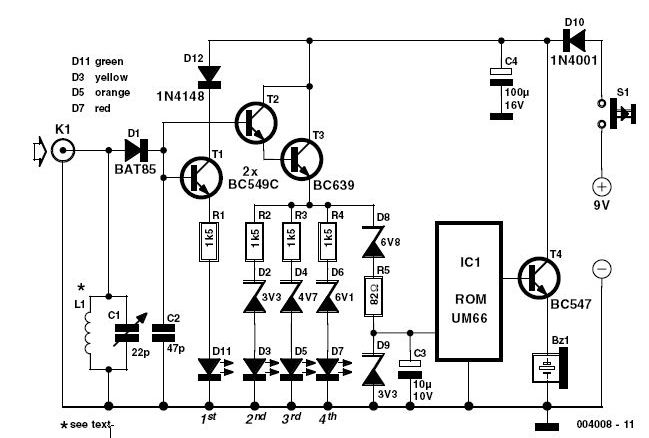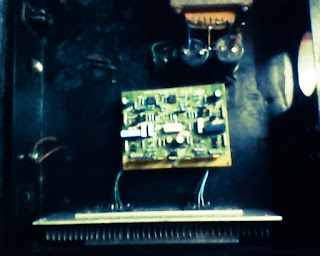- Loudspeaker
amplifier: when powered by a 9V alkaline battery it can deliver about
1.5W peak output power to the incorporated loudspeaker. - Headphone
amplifier or low power loudspeaker amplifier: when powered by a 3V
battery (2x1.5V cells) it can drive any headphone set type at a
satisfactory output power level or deliver to the incorporated
loudspeaker about 60mW of output power. This configuration is useful for
saving battery costs. - Fuzz-box: when powered by a 3V battery
(2x1.5V cells) and having its output connected to a guitar amplifier
input the circuit will behave as a good Fuzz-box, showing an output
square wave with marked rounded corners, typical of valve-circuits
output when driven into saturation.
R1______________22K 1/4W Resistor
C1______________10µF 25V Electrolytic Capacitor
C2_____________100nF 63V Polyester or Ceramic Capacitor
C3_____________220µF 25V Electrolytic Capacitor
IC1__________TDA7052 Audio power amplifier IC
J1,J2__________6.3mm Stereo Jack sockets (switched)
SPKR___________8 Ohm Loudspeaker (See Notes)
B1________________9V PP3 Battery or 3V Battery (2 x 1.5V AA, AAA Cells in series etc.)
Clip for PP3 Battery or socket for 2 x 1.5V AA or AAA Cells
Notes:
- For
the sake of simplicity and compactness, this unit employs a dual
bridge IC amplifier and a few other parts. For the same reason no
volume or tone controls are provided as it is supposed that the
controls already existing on the electric guitar will serve
satisfactorily to the purpose. - No power switch is used: the
battery voltage will be applied to the circuit when the input plug will
be inserted in the input jack socket J1. For this purpose be sure that
the input plug is a common 1/4 inch guitar mono jack plug and J1 is a
1/4 inch stereo jack socket. - The output jack socket J2 must be a
switched stereo type. The changeover switching is arranged in such a
way that, when a common headphones stereo jack plug is inserted into
the socket, the loudspeaker will be disabled and the mono output signal
will drive both the headsets in series, allowing full headphone
reproduction. When used as a Fuzz-box output, a mono jack plug must be
inserted into J2. - If the amplifier is intended to be encased in a packet of cigarettes, standard loudspeaker diameter should be 57 or 50mm.
Max output power: 1.5W @ 9V supply - 8 Ohm load; 60mW @ 3V supply - 8 Ohm load
Frequency response: Flat from 20Hz to 20kHz
Total harmonic distortion @ 100mW output: 0.2%
Max input voltage @ 3V supply: 8mV RMS
Minimum input voltage for Fuzz-box operation: 18mV RMS @ 3V supply
Current consumption @ 400mW and 9V supply: 200mA
Current consumption @ 250mW and 9V supply: 150mA
Current consumption @ 60mW and 3V supply: 80mA
Quiescent current consumption: 6mA @ 9V, 4mA @ 3V supply
Fuzz-box current consumption: 3mA @ 3V supply




















 Analog Versatile Circuit MIC 640 Acquisition System
Analog Versatile Circuit MIC 640 Acquisition System Electronic devices should be powered by direct current supply of DC (direct current) which is stable in order to work properly. The battery or batteries are the source DC power supply is best. However, for applications that require power supplies larger, the source of the battery is not enough.
Electronic devices should be powered by direct current supply of DC (direct current) which is stable in order to work properly. The battery or batteries are the source DC power supply is best. However, for applications that require power supplies larger, the source of the battery is not enough.




